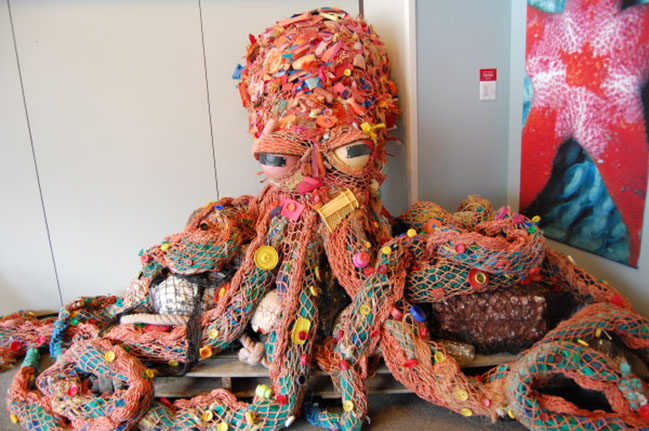One of the main focuses for the 2014 summer Seabird Camp on St. Paul Island is Marine Debris. We’re going to be doing a beach clean up, conduct an experiment looking at the degradation of plastic in the ocean, work with the “Stow-It-Don’t-Throw-It” group to make containers for used fishing line, and make some cool art from marine debris.
[separator type=’transparent’ color=” thickness=’1′ up=” down=”]
So…. What is Marine Debris?
Marine debris (or marine litter) is waste material made by humans that end up in the ocean. Debris can include a wide assortment of items including: plastic bottles; fishing nets; bags; polystyrene, and cigarette lighters. The floating debris accumulates on beaches and coastlines and in the centers of gyres.
What are gyres? Large systems of ocean currents, coupled with wind and the earth’s rotation, create “gyres”, massive, slow rotating whirlpools in which plastic trash can accumulate. Designed to last, plastic trash in a gyre will remain for decades or longer, being pushed gently in a slow, clockwise spiral towards the center. Most of the research on plastic trash circulating in oceanic gyres has focused on the North Pacific, but there are 5 major oceanic gyres worldwide, with several smaller gyres in Alaska and Antarctica.
Hundreds of millions of metric tons of plastic debris currently floats in the ocean. The plastic gets broken into small pieces and scattered throughout the water column. There are no visible islands of trash anywhere, but rather an ocean soup laced with plastic. This makes cleaning the oceans very difficult, technically and economically. Any cleanup has the potential to not only remove the plastics but also the plankton, which are at the base of the food chain and responsible for capturing half of the CO2 in our atmosphere and generating half of the oxygen we need to breathe.
[separator type=’transparent’ color=” thickness=’1′ up=” down=”]
Why is marine debris a problem?
Animals that live in the sea can become tangled in the floating debris, or eat the floating particles by mistake because it often looks similar to their natural prey. 44% of all seabird species, 22% of cetaceans (whales, dolphins, porpoises), all sea turtle species, and many fish species have been documented with plastic in or around their bodies. When marine animals consume plastic trash, this can lead to internal blockages, dehydration, starvation, and potentially death.
Plastic pollution may also affect the health of humans. As plastic particles circulate through oceans, they act as sponges for waterborne contaminants such as PCBs, DDT and other pesticides, PAHs and many hydrocarbons that are washed into the ocean. These persistent organic pollutants, called “POPs”, are absorbed in the plastic pollution in high concentrations. Scientists are beginning to ask: “do chemicals such as PCBs and DDTs that are absorbed onto plastic pellets get into the tissues and blood of the animals that eat plastic?” “Do these chemicals work their way up the food chain, becoming increasingly concentrated and potentially entering our bodies when we eat seafood?”
[separator type=’transparent’ color=” thickness=’1′ up=” down=”]
Cool online resources on marine debris and plastic pollution to check out:
Algalita Marine Research Institute
The Gyre exhibit is currently showing at the Anchorage Museum
Check out this beautifully made movie about marine debris in Alaska:

